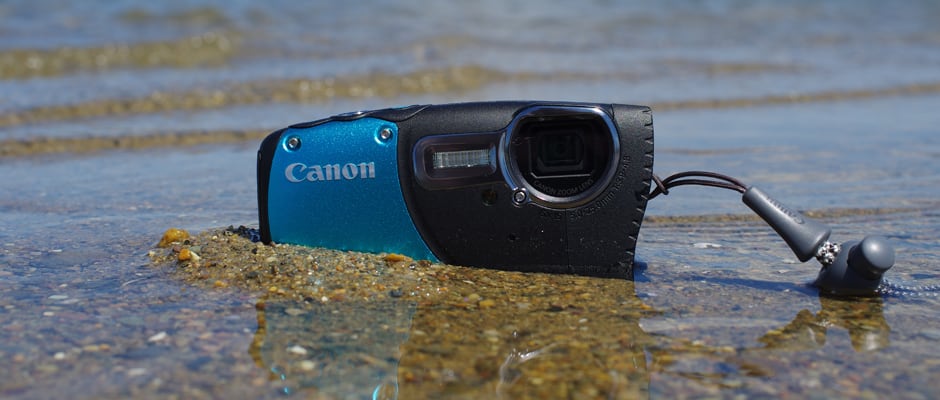Introduction
The PowerShot D20 is Canon's latest waterproof, shockproof, and generally accident-proof camera. It was released in 2012, making it one of the older tough-cams among the current crop.
Competition is stiff in the category this year. Canon chose not to refresh their waterproof PowerShot for 2013, and as such, the D20 doesn't quite stand up to its competitors the way that it did in 2012. Read on for our hands-on review, conducted last year, or jump to our 2013 waterproof camera showdown for our breakdown of the current market.
The Canon D20 is available now in blue for an MSRP of $349.
Design & Usability
{{section_header}}{{section.name}}{{/section_header}}
As with any tough-cam, the build quality is the main selling point on the Canon D20.
It looks more like a toy than a tank, but the D20's waterproof and shockproof ratings sit among the toughest of the tough-guys in the class. It’s reminiscent of 2009's Canon D10, but more rectangular and less bulbous. There’s nothing to grip on the front of the camera, and while the camera looks like it’s wrapped in rubber or some other kind of textured material, it’s actually just plastic. But thanks to the curves, it’s comfortable to hold, and the textured thumb-rest on the back provides some amount of leverage.
For the most part, the D20 is a straightforward, user-friendly point-and-shoot—no experience is required. It’s quick and responsive, and it works great in auto mode. It isn’t perfect, though. The button layout and labeling are a bit obtuse; there should be one more multifunction button on the rear panel, but designers ran out of space.
As for hardware, the optics are noteworthy, anchored by a 12-megapixel CMOS sensor and a Digic 4 processor, though the 5x lens starts at a mediocre f/3.9. The lens is all-internal, though, shielded behind a glass barrier for protection. A 3-inch, 461k-pixel LCD is big and bright enough to be visible in bright daylight, but it’s a bit grainy in low-light, and there’s a slight lag.
{{photo_gallery "Front Photo", "Back Photo", "Sides Photo", "Top Photo", "Bottom Photo", "Lens Photo", "Lens Photo 2", "3D Lens Photo", "Media Photo", "Easy Mode Photo", "Manual Controls Photo 1", "Manual Controls Photo 2", "Zoom Photo", "Zoom Photo 2", "Ease of Use Photo", "Battery Photo", "LCD Photo 1", "LCD Photo 2", "EVF Photo 1", "EVF Photo 2", "Ports Photo 1", "Ports Photo 2", "Ports Photo 3", "Ports Photo 4", "Ports Photo 5", "Ports Photo 6", "Handling Photo 1", "Handling Photo 2", "Handling Photo 3", "Handling Photo 4", "Buttons Photo 1", "Buttons Photo 2", "Buttons Photo 3", "Box Photo"}}
Features
{{section_header}}{{section.name}}{{/section_header}}
Durability is of utmost importance to a tough-cam like the PowerShot D20.
Durability is the main feature of the D20. It costs $349 because it can withstand bumps, bruises, and splashes. Like most of this year’s tough-cams, the D20 comes with a GPS antenna for geo-tagging photos, which works fairly well. Otherwise, the feature set is basically standard for a point-and-shoot, if a bit on the sparse side.
If we trust Canon’s durability ratings (and there’s no reason not to), the Canon D20 isn’t the most overall rugged camera on the market, but it’s competitive with the most tank-like compacts out there: It’s waterproof to 33 feet, it’s shockproof to five feet (the hardiest camera can fall from 6.6 feet—over most people’s heads, but 5 feet is still competitive), it’s freezeproof to 14 degrees Fahrenheit, and it’s dustproof as well. The caveats? It is not designed to survive in heated water, like hot springs, and the camera needs to be cleaned after dips into salt water. Moreover, according to the manual, “waterproof performance is not ensured if the camera is dropped or subjected to impact,” so while Canon advertises the D20 as a shockproof camera, that confidence only extends so far, apparently.
The fact is, though, for most people, the D20 is durable enough for general underwater and outdoor use. Like most tough-cams, the D20 is meant to be used in auto mode while you’re busy swimming or hiking. Auto mode takes over most of the camera’s functions. GPS settings, the timer, picture size and resolution, and flash settings can still be adjusted, but otherwise, the shot is in the hands of D20, and it does a fine job. Otherwise, this device is rather feature light, though it does feature 11 fun color modes.
Performance
{{section_header}}{{section.name}}{{/section_header}}
Like most recent PowerShots built around the HS system, the D20 can work well in a variety of shooting situations, but it’s best used as an outdoor camera.
In bright lighting, the D20's images are accurate, crisp, and vibrant—even underwater, where details and colors usually look flat. Our lab scores are strong across the board, so shots can look decent in dimmer lighting. But with a slow, f/3.9 lens and unremarkable stabilization, photos blur pretty easily. A solid shooter for sure, but not an ideal all-around camera.
Image sharpness is acceptable—quite sharp at the center of the frame, particularly at the widest setting, but the in-between areas are noticeably soft and sloppy. As with any point-and-shoot, the D20 applies some artificial pixel sharpening to increase contrast, but it’s pretty judicious, so regular viewing sizes turn out well.
We measured relatively high levels of noise in the D20’s photos, but Canon’s clever noise reduction software keeps shots looking nice through ISO 1600, if a bit smooth. In real-world terms, outdoor shots (usually ISO 400 and lower) will look great, and noise won’t get in the way of capturing decent indoor snapshots—but a slow lens will! Like most tough-cams then, the D20 just isn't an all-around reliable shooter.
Conclusion
{{section_header}}{{section.name}}{{/section_header}}
We recommend the D20 as a solid beach camera—but if your adventures take place indoors, you may want to keep browsing.
By our count, there are no less than 15 new waterproof cameras in the 2012 model year. We’ve never seen the pool so crowded before. The industry is counting on these adventure-ready cameras to close the sales gap left where cheap point-and-shoots used to be.
The Canon PowerShot D20 is a worthy option. Image quality is very solid by tough-cam standards. Outdoors, colors are realistic yet vibrant, and details are crisp enough for sharing online and making regular prints. Underwater photos are rich and punchy. The design and interface are approachable and responsive, and the camera itself is adventure-ready, of course. But the crummy lens is the weak point. There are noticeable resolution problems at larger viewing sizes, and since the aperture starts at a sluggish f/3.9, it’s more difficult than usual to take a crisp shot in dim lighting. Also, the D20's smooth, rounded design can be hard to handle, especially when it’s wet, and while the GPS works pretty well, the feature set is missing some of the coolest extras offered in other tough-cams.
As we said, competition is stiff this year. The D20 is a solid outdoor camera, particularly well-suited to casual photographers who want a hands-off, user-friendly experience. Otherwise, there isn’t much here to separate the D20 from the tough-cam herd. It feels like Canon wrapped a regular ELPH in a waterproof, shock-resistant case, rather than designing an adventure-ready camera from the ground up. And with hit-or-miss indoor performance, it can’t be an all-around shooter like a regular ELPH.
Check out our 2013 waterproof camera showdown to see how the D20 compares with the year's best tough-cams.
Science Introduction
{{section_header}}{{section.name}}{{/section_header}}
The Canon PowerShot D20 backs its $349 price tag with toughness: this camera can brave the outdoors, shrugging off the wind, the dirt, and the rain. That's what you're paying for, so as expected, the D20's image quality is average compared to the whole, though pretty solid within the realm of tough-cams. It does a great job with bright, outdoor locales, and it overemphasizes colors just enough to make it a viable underwater shooter.
Low Light
{{section_header}}{{section.name}}{{/section_header}}
The D20's slow lens in a big obstacle.
Low-light image quality is fine—if you can manage to hold the camera steady. Up at ISO 1600, noise performance is just dandy for sharing online and making small prints, but the problem is that the f/3.9 lens is way too narrow, which forces the shutter to slow down in low light, which means you’ll be taking lots of blurry pictures if you’re hand-holding the camera. In that regard, it isn’t an ideal indoor or low-light camera.
The ISO range stretches from ISO 100 to 3200 in full stops. Users can set the sensitivity, or leave it up to the camera (which seems to cap the sensitivity at ISO 1600—a smart move). In Low Light mode, the range can extend up to ISO 6400 if the camera deems it necessary, but it’s recorded at a much lower resolution.
{{photo_gallery "Science Section 1 Images"}}
Distortion & Noise
{{section_header}}{{section.name}}{{/section_header}}
The D20 suffers some very obvious color fringing, and though noise is certainly present, this camera manages it well.
Chromatic aberration is a problem on the D20. At the wide and telephoto focal settings, aberration is plainly obvious everywhere except at the center of the frame. In real world terms, there’s a lot of green and purple color fringing in high-contrast areas: tree branches, edges of buildings, and the like. Viewed at small sizes, it doesn’t jump out, but it makes details look sloppier than they should.
We also measured relatively high levels of noise, but Canon's clever noise reduction software keeps shots looking good through ISO 1600, if a bit smooth. The noise-to-signal ratio climbs pretty consistently throughout the entire range, starting at a reasonable 0.83% at the base ISO, and topping out at 2.17% at ISO 3200 (which we wouldn't recommend using).
{{photo_gallery "Science Section 2 Images"}}
Video
{{section_header}}{{section.name}}{{/section_header}}
A cinematic look
The Canon D20 records at a maximum resolution of 1080p at 24 frames per second. That frame rate lends a cinematic quality to clips, though it makes moving objects stutter noticeably. There's a bit of frequency interference and trailing, but they aren't particularly problematic. Artifacting is not a problem.
Bright-light sharpness is about what we expect to see from a point-and-shoot. We measured 400 horizontal and 375 vertical lw/ph—pretty nice for a camera that shoots at 24fps. Low-light sharpness shows a predictable drop-off in sharpness, though—250 horizontal and 225 vertical lw/ph. The D20 crossed our threshold for low-light sensitivity at 19 lux. That's respectable for a point-and-shoot—most of the compacts we see bottom out around 30 lux.
{{photo_gallery "Science Section 3 Images"}}
Other Tests
{{section_header}}{{section.name}}{{/section_header}}
{{photo_gallery "Other Tests Images"}}
Meet the tester
Liam manages features and news coverage for Reviewed.com. Formerly the editor of the DigitalAdvisor network, he's covered cameras, TVs, personal electronics, and (recently) appliances. He's a native Bostonian and has played in metal bands you've never heard of.
Checking our work.
Our team is here to help you buy the best stuff and love what you own. Our writers, editors, and experts obsess over the products we cover to make sure you're confident and satisfied. Have a different opinion about something we recommend? Email us and we'll compare notes.
Shoot us an email

